Basic Procedures and Rules for All Card Games
There are a number of basic procedures and rules that are common to almost every game of cards that is played. In the following text, we will describe these general procedures that will normally be used with almost any card game.
To begin with, every card game requires the specific equipment needed to play that game. Although some games may require such additional hardware as score pads, pencils or tokens, for most games usually the sole requirement is the Deck of cards itself:
The Deck: Every game of cards requires a deck for use in which to play that game. This deck is a collection of the specific cards used for that particular game. Many of the commonly played card games use what is known as the standard deck. This is the traditional deck of cards containing the 52 cards most people are familiar with. A number of other games also use this deck with various modifications to this deck (removing or adding specific cards). See this article for detailed information regarding this standard deck and some of its common variations.
Every game also consists of one or more participants in that game, called the players of that game. In addition to these players there may be a number of other individuals watching the proceedings but who are not actually playing. These individuals who are watching and do not have any active part of the actual game are called kibitzers.
Players: From games for one player (solitaire) to games played by 10 or more, every game is designed for a specific number (or range) of players. While some games may call for a specific and exact number of players (such as Bridge) others may allow varying number of players without drastically altering the rules or procedures for the game. Some of the games that do specify a set number of players often have variations that can be played with other numbers of players. For games which do allow varying numbers of players, the game rules usually offer a recommended range of such players in which the game is usually at its best (Fewer or more players would make the game unwieldy or impractical to play). It is recommended when such a number or range is given that these guidelines be followed for maximum enjoyment of the game as described.
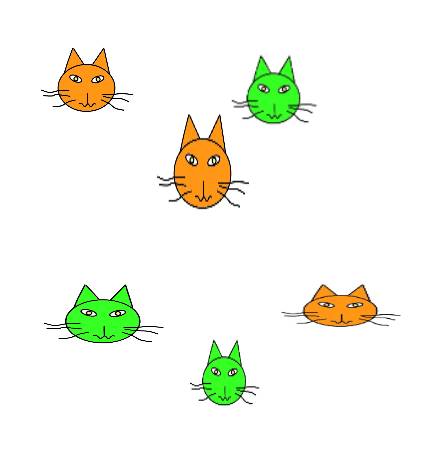 Games with more than two players usually fall into two general categories. Cutthroat games, where each player plays for himself in an effort to win and Partnership games where players will team up with one or more other players with the same goal, to win the hand or game against other partnerships made up of two or more of the other players. When these partnerships are used, both members of the partnership usually score as a team (if the game rules specify keeping a score), while in cutthroat games each player would retain an individual score. In games that do keep a score, often one particular player (possibly the first dealer) is specified as the scorekeeper and will record the scores for all players or partnerships.
Games with more than two players usually fall into two general categories. Cutthroat games, where each player plays for himself in an effort to win and Partnership games where players will team up with one or more other players with the same goal, to win the hand or game against other partnerships made up of two or more of the other players. When these partnerships are used, both members of the partnership usually score as a team (if the game rules specify keeping a score), while in cutthroat games each player would retain an individual score. In games that do keep a score, often one particular player (possibly the first dealer) is specified as the scorekeeper and will record the scores for all players or partnerships.
In some circumstances there may be an uneven number of players as needed for the game to be played. For instance, there may be five such players wanting to play a game requiring only four. Obviously, if there are enough participants for a number of separate and complete full tables or games to be played this should be done, but often there is an uneven number of such players.
In such cases where there are more players than the game is designed to accommodate, the general method to resolve this is to have all players draw from a shuffle deck with the lowest such cards drawn sitting out for the first game. These players would then rotate in for the next game to be played and this rotation would continue for the duration of the game session. Many games also feature variations allowing for differing number of players, often having all participants seated at the table, but only certain individuals receiving cards on each hand. See this link for procedures on handling extra players in a card game.
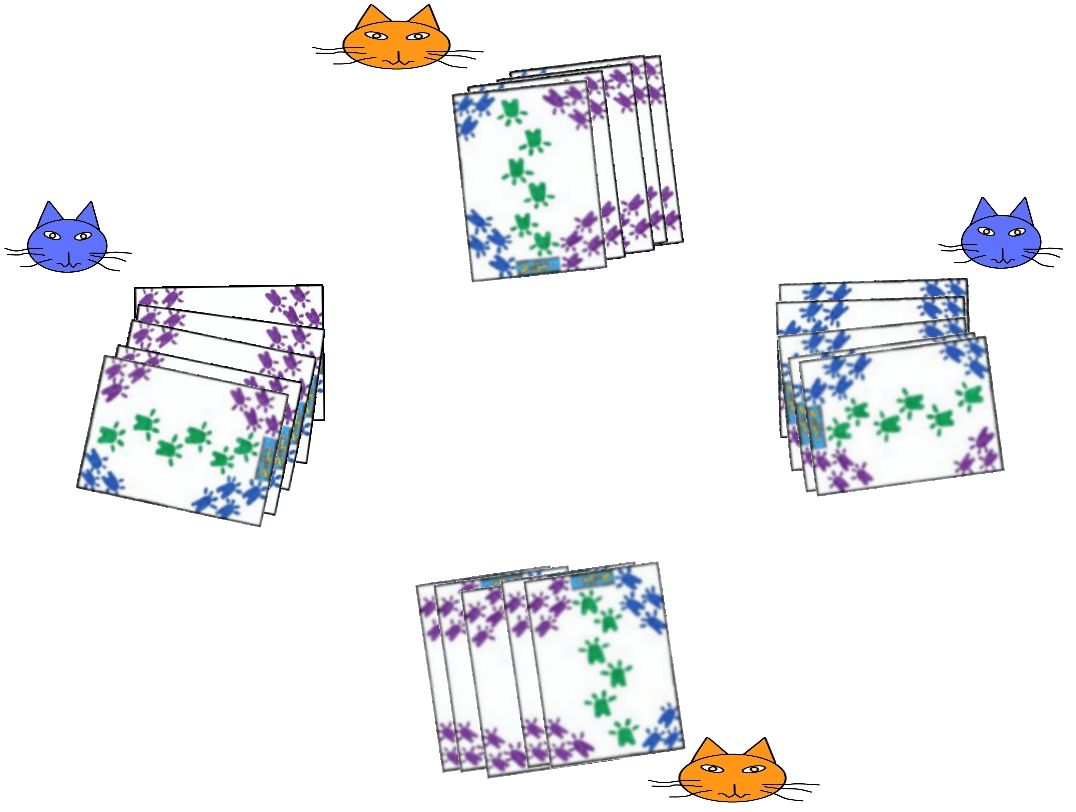 Partnerships: For games that do feature partnerships, there are a number of ways in which these partnerships can be determined. Oftentimes with a regular group of card players or in a club these partnerships may be pre-determined or follow a specific rotating pattern. If this is not the case, then one of the first orders of business would be determining these partnerships. Two of the more common methods of doing this is drawing for partnerships or cutting for such partnerships. Most games that are played in partnerships, usually are played by two partnerships of two players each, however some other arrangements are used for various games. See this article for detailed information and procedures for selecting partnerships.
Partnerships: For games that do feature partnerships, there are a number of ways in which these partnerships can be determined. Oftentimes with a regular group of card players or in a club these partnerships may be pre-determined or follow a specific rotating pattern. If this is not the case, then one of the first orders of business would be determining these partnerships. Two of the more common methods of doing this is drawing for partnerships or cutting for such partnerships. Most games that are played in partnerships, usually are played by two partnerships of two players each, however some other arrangements are used for various games. See this article for detailed information and procedures for selecting partnerships.
Seating Positions and Selection of the First Dealer:After determining partnerships in those games that require them, the players would next determine their specific seating positions at the card table. With partnerships, this will be partially determined by the specific players in the partnerships, as in most games that feature partnerships, the partners usually sit opposite each other at the table, with players from the opposing partnership sitting between that player and his partner. In games where each player plays for himself, there are usually similar procedures for determining seating position as for determining partnerships (cutting or dealing of cards). Oftentimes, as part of determining seating position, the same procedures also determine who is to be the first dealer. This determination of first dealer and determination of seating positions at the card table also directly correlates to the order of play during the game. See this article for more detailed information regarding determination of first dealer and players seating positions.
Other Equipment:
In addition to the normal equipment needed to play a game, some games may have additional requirements. This is usually a pad of paper or some other score sheet and a writing implement to record the individual players scores. Usually only one player is selected to keep the score for all the players during a game. In partnership games, sometimes one member of the partnership is selected to track and record all the scores for their partnership. Some games will distribute a set number of chips or tokens prior to the beginning of the game and the players will collect or pay such chips depending on the outcomes of hands during the game.
Shuffling the Deck: After the players are seated and the first dealer is determined the deck should then be thoroughly shuffled. Shuffling is the act of randomizing the cards in the deck such that the whereabouts of any card or group of cards cannot be determined by any player. The dealer is usually the one who shuffles the deck, preferably several times before beginning the hand. In addition, any other active player in the game can also ask to shuffle, however the dealer reserves the right to shuffle last. There are a variety of shuffling methods that are commonly used at card games throughout the world. See this article for more detailed information as well as instructions on how to perform the most common shuffles.
Using a New Deck: When a new deck is first purchased and removed from the plastic shrink wrap, it is usually packaged in a specific and ordered manner, arranged first by suit and then by denomination in that suit. This arrangement of a fresh deck is almost always in the following order. The bottom, face up card would be the Ace of Spades, next the deuce of Spades, and continuing in ascending order up to the King of Spades. The sequence then begins again from Ace to King in Clubs, followed by Ace through King in the Hearts suit and then lastly, the sequence repeats in the suit of Diamonds.
Thus, when playing a game with such a new deck, it is very important to ensure to perform a very thorough shuffle before playing the first game. A specific shuffling method is sometimes used with a new deck, called the wash. Although the wash is a very basic shuffle, when done correctly the wash will usually mix the deck thoroughly before beginning play. In addition, with a deck of plastic coated cards, the new deck will be very slick and thus the mechanics of shuffling, cutting and dealing may need to be done with more deliberate and controlled hand motions then when using a somewhat more worn deck.
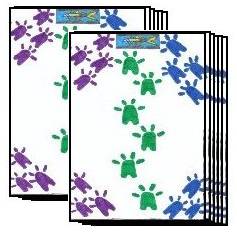 Cutting the Deck: After the shuffle has been completed, the dealer then offers the deck to the first player in the opposite direction of the play of the hand and distribution of the cards (see below). This player would then perform a cut of the cards and return the deck to the dealer to begin the deal. This player can turn down the option to cut, at which time the dealer should then perform the cut. Cutting is usually performed in order to help prevent cheating or the identification of the location of a specific card in the deck. However, cutting does not actually change the ordering of the cards themselves. See this article for detailed information regarding cutting of the cards and instructions on how to perform this integral action.
Cutting the Deck: After the shuffle has been completed, the dealer then offers the deck to the first player in the opposite direction of the play of the hand and distribution of the cards (see below). This player would then perform a cut of the cards and return the deck to the dealer to begin the deal. This player can turn down the option to cut, at which time the dealer should then perform the cut. Cutting is usually performed in order to help prevent cheating or the identification of the location of a specific card in the deck. However, cutting does not actually change the ordering of the cards themselves. See this article for detailed information regarding cutting of the cards and instructions on how to perform this integral action.
Dealing: After the cards are shuffled and cut, the dealer would then begin dealing the cards. Dealing is the procedure of distributing the cards necessary for the particular game being played to each player, with each player eventually receiving a set, equal number of cards.
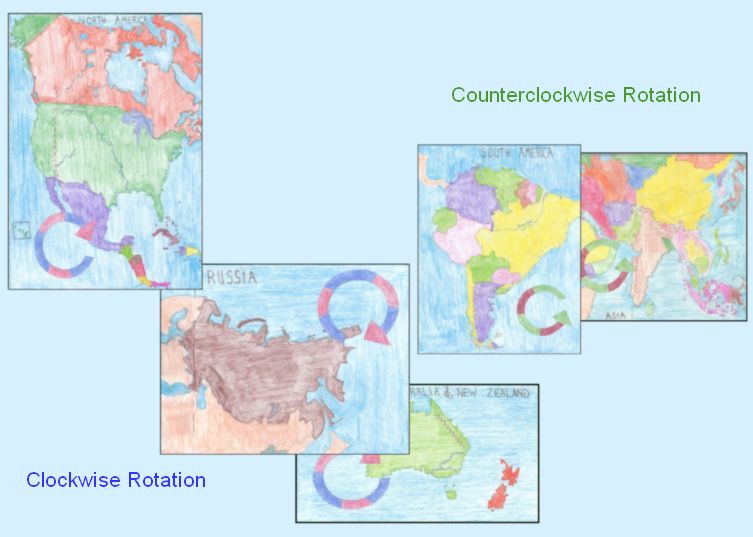 For most games the cards are dealt one at a time in multiple rounds in rotation around the table. However in some games they can be dealt in small multi-card packets instead of individually, but usually still in multiple rounds of dealing in rotation around the table. Dealt cards are usually placed face down in front of each player, although in certain instances one or more cards might be dealt face up.
When dealing the cards are dealt either in a clockwise or counterclockwise direction. The specific direction for this dealing is determined either by the specific game being played or the geographical location in which the game is being played. Regardless of which direction the cards are dealt, the dealer is usually the last to receive cards in each rotation of card distribution. See this article for detailed information regarding the dealing of the cards.
For most games the cards are dealt one at a time in multiple rounds in rotation around the table. However in some games they can be dealt in small multi-card packets instead of individually, but usually still in multiple rounds of dealing in rotation around the table. Dealt cards are usually placed face down in front of each player, although in certain instances one or more cards might be dealt face up.
When dealing the cards are dealt either in a clockwise or counterclockwise direction. The specific direction for this dealing is determined either by the specific game being played or the geographical location in which the game is being played. Regardless of which direction the cards are dealt, the dealer is usually the last to receive cards in each rotation of card distribution. See this article for detailed information regarding the dealing of the cards.
Play of the Hand: Once all of the preliminaries are completed, the players would usually pick up their dealt cards and the game would begin. Depending on the game being played, this could consist of bidding, melding, drawing or any other action appropriate to that particular game. The dealer is always the last to play in every round of plays, with the first player to play being dependent on the direction of rotation used in the play. This direction of play is identical to the direction used in the dealing of the cards, with the first player to play being the same who received the first card or cards in the deal.
Game Over: Many games consist of a number of hands, with each player striving to win a set number of hands or accumulate a specific number of points, after which time they are declared the winner of the game. Many games are done on a hand by hand basis, where each deal hand is considered a complete game, although a number of such games might be played during the course of a game session. At the completion of a game, any player can call for a new draw and deal for seating positions, partnerships (if applicable) and first dealer. Alternatively, once initial partnerships or seating positions have been determined, there may be a simple rotation of the first dealer or partnerships for the next game. The next game usually starts off with scores of 0 for every player or partnership, as it is considered a new game. Sometimes a winner for the entire game session may be declared, which might be the player who won the most games or accumulated the most total points over the course of all of the games played.
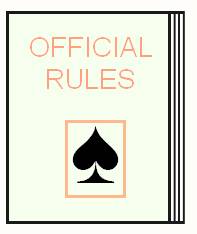 Official Rules: Many games (such as Bridge and Skat) have rules committees and "official" rules which can be followed when playing these games. However, a number of other games do not necessarily have an official set of rules and a number of different variations, even for the basic game, may be found. In any case, all players should agree on the set of rules (whether official or not) they intend to follow with the primary purpose being for the players to have fun and enjoy the game. When multiple sets of rules or variations do exist, there is no particular reason to specifically follow one set of rules over another, although generally, printed rules, when found usually have been designed to help keep the game enjoyable and contributing to the overall fairness of the game. The important thing in all of this is for all players to understand, be aware of and agree on the set of rules to be played for a particular game. Almost every game played will have a number of table or house rules that will vary based on the locality, situation and personality of the participants. In tournaments however, it is strongly recommended (and almost always required) to use the "official" rules of a game, if any exist, for that particular game.
Official Rules: Many games (such as Bridge and Skat) have rules committees and "official" rules which can be followed when playing these games. However, a number of other games do not necessarily have an official set of rules and a number of different variations, even for the basic game, may be found. In any case, all players should agree on the set of rules (whether official or not) they intend to follow with the primary purpose being for the players to have fun and enjoy the game. When multiple sets of rules or variations do exist, there is no particular reason to specifically follow one set of rules over another, although generally, printed rules, when found usually have been designed to help keep the game enjoyable and contributing to the overall fairness of the game. The important thing in all of this is for all players to understand, be aware of and agree on the set of rules to be played for a particular game. Almost every game played will have a number of table or house rules that will vary based on the locality, situation and personality of the participants. In tournaments however, it is strongly recommended (and almost always required) to use the "official" rules of a game, if any exist, for that particular game.
House Rules: It is common practice for many card playing groups to have their own preferred variations or optional rules for a particular game. This may be one of the common variations for that game or something that is unique to that group or in that area. Thus, when playing with a new group, a player should familiarize himself with all of the local or house rules before beginning play. In the various game descriptions given on this site, all or most of the commonly played variations and optional rules have been included. Generally, in a tournament setting, these custom or house rules should be avoided and the official rules for that game (if published) should be used.
Irregularities: An irregularity is any action that breaks the regular rules of the game in a way potentially detrimental to the other players or giving any player a possible unfair advantage. These irregularities are generally unintentional and carry some type of penalty such that the player who performed the infraction does not get an undue advantage by the irregularity. This penalty might include losing a turn, exposing the next card they draw or giving some number of points to the opposing players. In no case, in any group of players, should a player who intentionally attempts to knowingly break the rules be allowed to continue play. Such a player can cause much animosity amongst the other players and compromises the entire reason for playing a game of cards to begin with. Such players will quickly learn that such behavior will not be tolerated and is not welcome in any group of card players.
Copyright © 2015 CatsAtCards.com. All rights reserved.


 Games with more than two players usually fall into two general categories. Cutthroat games, where each player plays for himself in an effort to win and Partnership games where players will team up with one or more other players with the same goal, to win the hand or game against other partnerships made up of two or more of the other players. When these partnerships are used, both members of the partnership usually score as a team (if the game rules specify keeping a score), while in cutthroat games each player would retain an individual score. In games that do keep a score, often one particular player (possibly the first dealer) is specified as the scorekeeper and will record the scores for all players or partnerships.
Games with more than two players usually fall into two general categories. Cutthroat games, where each player plays for himself in an effort to win and Partnership games where players will team up with one or more other players with the same goal, to win the hand or game against other partnerships made up of two or more of the other players. When these partnerships are used, both members of the partnership usually score as a team (if the game rules specify keeping a score), while in cutthroat games each player would retain an individual score. In games that do keep a score, often one particular player (possibly the first dealer) is specified as the scorekeeper and will record the scores for all players or partnerships.
 Partnerships: For games that do feature partnerships, there are a number of ways in which these partnerships can be determined. Oftentimes with a regular group of card players or in a club these partnerships may be pre-determined or follow a specific rotating pattern. If this is not the case, then one of the first orders of business would be determining these partnerships. Two of the more common methods of doing this is drawing for partnerships or cutting for such partnerships. Most games that are played in partnerships, usually are played by two partnerships of two players each, however some other arrangements are used for various games. See this article for detailed information and procedures for selecting partnerships.
Partnerships: For games that do feature partnerships, there are a number of ways in which these partnerships can be determined. Oftentimes with a regular group of card players or in a club these partnerships may be pre-determined or follow a specific rotating pattern. If this is not the case, then one of the first orders of business would be determining these partnerships. Two of the more common methods of doing this is drawing for partnerships or cutting for such partnerships. Most games that are played in partnerships, usually are played by two partnerships of two players each, however some other arrangements are used for various games. See this article for detailed information and procedures for selecting partnerships.
 Cutting the Deck: After the shuffle has been completed, the dealer then offers the deck to the first player in the opposite direction of the play of the hand and distribution of the cards (see below). This player would then perform a cut of the cards and return the deck to the dealer to begin the deal. This player can turn down the option to cut, at which time the dealer should then perform the cut. Cutting is usually performed in order to help prevent cheating or the identification of the location of a specific card in the deck. However, cutting does not actually change the ordering of the cards themselves. See this article for detailed information regarding cutting of the cards and instructions on how to perform this integral action.
Cutting the Deck: After the shuffle has been completed, the dealer then offers the deck to the first player in the opposite direction of the play of the hand and distribution of the cards (see below). This player would then perform a cut of the cards and return the deck to the dealer to begin the deal. This player can turn down the option to cut, at which time the dealer should then perform the cut. Cutting is usually performed in order to help prevent cheating or the identification of the location of a specific card in the deck. However, cutting does not actually change the ordering of the cards themselves. See this article for detailed information regarding cutting of the cards and instructions on how to perform this integral action.
 For most games the cards are dealt one at a time in multiple rounds in rotation around the table. However in some games they can be dealt in small multi-card packets instead of individually, but usually still in multiple rounds of dealing in rotation around the table. Dealt cards are usually placed face down in front of each player, although in certain instances one or more cards might be dealt face up.
When dealing the cards are dealt either in a clockwise or counterclockwise direction. The specific direction for this dealing is determined either by the specific game being played or the geographical location in which the game is being played. Regardless of which direction the cards are dealt, the dealer is usually the last to receive cards in each rotation of card distribution. See this article for detailed information regarding the dealing of the cards.
For most games the cards are dealt one at a time in multiple rounds in rotation around the table. However in some games they can be dealt in small multi-card packets instead of individually, but usually still in multiple rounds of dealing in rotation around the table. Dealt cards are usually placed face down in front of each player, although in certain instances one or more cards might be dealt face up.
When dealing the cards are dealt either in a clockwise or counterclockwise direction. The specific direction for this dealing is determined either by the specific game being played or the geographical location in which the game is being played. Regardless of which direction the cards are dealt, the dealer is usually the last to receive cards in each rotation of card distribution. See this article for detailed information regarding the dealing of the cards.
 Official Rules: Many games (such as Bridge and Skat) have rules committees and "official" rules which can be followed when playing these games. However, a number of other games do not necessarily have an official set of rules and a number of different variations, even for the basic game, may be found. In any case, all players should agree on the set of rules (whether official or not) they intend to follow with the primary purpose being for the players to have fun and enjoy the game. When multiple sets of rules or variations do exist, there is no particular reason to specifically follow one set of rules over another, although generally, printed rules, when found usually have been designed to help keep the game enjoyable and contributing to the overall fairness of the game. The important thing in all of this is for all players to understand, be aware of and agree on the set of rules to be played for a particular game. Almost every game played will have a number of table or house rules that will vary based on the locality, situation and personality of the participants. In tournaments however, it is strongly recommended (and almost always required) to use the "official" rules of a game, if any exist, for that particular game.
Official Rules: Many games (such as Bridge and Skat) have rules committees and "official" rules which can be followed when playing these games. However, a number of other games do not necessarily have an official set of rules and a number of different variations, even for the basic game, may be found. In any case, all players should agree on the set of rules (whether official or not) they intend to follow with the primary purpose being for the players to have fun and enjoy the game. When multiple sets of rules or variations do exist, there is no particular reason to specifically follow one set of rules over another, although generally, printed rules, when found usually have been designed to help keep the game enjoyable and contributing to the overall fairness of the game. The important thing in all of this is for all players to understand, be aware of and agree on the set of rules to be played for a particular game. Almost every game played will have a number of table or house rules that will vary based on the locality, situation and personality of the participants. In tournaments however, it is strongly recommended (and almost always required) to use the "official" rules of a game, if any exist, for that particular game.